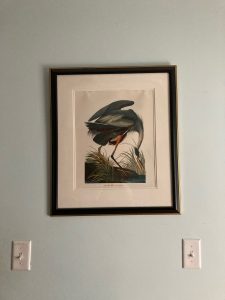In Class
Nothing as yet.

Nothing as yet.
You all will likely recognize this view,  as it’s been in the background for all my Zoom appearances, both this semester and last.
as it’s been in the background for all my Zoom appearances, both this semester and last.
It’s a print from John James Audubon’s Birds of America, a massive volume full of color illustrations created not merely as art but as science: an effort to establish “type specimens” of many birds.
It turns out that Audubon is a bit of a racist, though: link. I saw this article just this morning. It was the first I heard about Audubon’s history as a slave owner and racist. Read the article and then come back to class ready to discuss the real and pressing question of whether I need to remove that image from my wall.
On the tour Tuesday, we asked you to find and photograph something striking. Post your photograph in the comments below, together with a brief writeup (3-5 sentences, max) connecting what we see in the photo to our recent discussions of visual rhetoric and memorials.
Note: the max file size is 12MB, so if you’re having trouble with the attachment, that may be the problem. The other issue is with .heic files—open them and save-as or export to .jpg.
The French phrase “mise-en-scene” refers to everything that’s captured by the camera on a movie set: lighting, acting, props, scenery, etc. Continue reading
Through class discussion and learning experiences, students explore connections between readings assigned in Rhetoric and those in other courses, focusing on themes drawn from the two units that comprise the semester’s curriculum. The course further develops skills in expository writing and introduces exploratory essay writing. Students continue to explore the contemporary relevance and meaning of the interdisciplinary curriculum. Students refine their skills in grammar, style, organization, and document design. Effective Fall 2018, this course fulfills a single unit in the following BU Hub areas: First-Year Writing Seminar, Digital/Multimedia Expression, Critical Thinking.